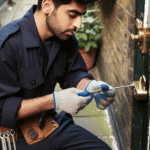Homeowners who want to protect a property’s rich history can shield historic homes from decay while boosting their livability through careful upkeep and well-planned improvements. When restoration plans honor original materials and craftsmanship—but also include current standards for durability, comfort, and energy performance—the outcome is a home that appears and feels genuine, runs, and gives its caretakers lasting value.
Envelope Preservation
A building’s outer shell that stays true to its original look while standing up to the weather is key for any historic fix-up job. Start by doing a full check of the siding, stonework, and roof to spot bad mortar joints, rotted wood siding, or rusty flashings. Fix brick and stone with mortar that matches the old work in makeup, color, and joint shape, making sure water runs off well without changing the historic façade. When you need to swap out boards, find wood types and shapes that look like the old ones; use 3D scans or old pieces you still have to help make new parts that fit right into the original exterior shell.
Roof flashings need extra care: take out low-profile metals that no longer perform and install new materials—copper, lead-coated copper, or terne—shaped to follow the original rooflines. These upgrades help water flow away from weak spots like eaves, chimneys, and dormers. Laying underlayment membranes beneath new shingles or metal panels creates a backup defense against wind-driven rain, protecting the interior from leaks. Windows play a crucial role in the building envelope, so consider hiring a professional DFW window replacement team to install energy-saving units that look period-correct. These modern sashes preserve original sightlines and glazing patterns while sealing out drafts and moisture.
Mechanical Integration
Updating the heating, cooling, and electrical systems in an old house needs a gentle touch. Instead of throwing out the original steam radiators or painted cast-iron registers, give them a makeover by hooking them up to high efficiency condensing boilers or modular hydronic systems that pump out more heat for each unit of fuel. Make sure to insulate the hot water or steam pipes—including the hidden ones in basements and attics—to stop unnecessary heat from escaping and to cut down on running costs.
When adding air conditioning, look at less intrusive options like high-velocity mini-duct systems or hidden ductless split units. These fit in existing chases or small wall spaces keeping plaster walls and fancy trim safe. Always hide coolant lines and wiring in baseboards or behind covers that match the era to keep the look intact.
For electrical updates, start by swapping out dangerous knob-and-tube or cloth-covered wiring with wires that meet code running them through existing spaces. This keeps original plaster, paneling, and moldings untouched. Keep old light fixtures and wall sconces, rewire them inside, and use LED bulbs or ones you can dim to mix old-style looks with new-age efficiency.
Material Selection
Honoring originality applies to every board, molding, and finish layer. When you can’t save all the historic flooring—like wide-plank pine, quarter-sawn oak, or geometric tile—reuse existing boards to patch things up and create new planks that match the width, grain, and finish. To recreate wood trim and moldings, capture the existing profiles using digital scans or saved patterns then make copies in the same type of wood and size.
Paint and finish choices should let the building’s structure breathe. Pick paints and stains that allow vapor to pass through helping moisture move from the base material. This protects wood, masonry, and plaster from getting damp. Choose colors that match the building’s history—you can find these by looking at old paint chips or color guides from that time. Modern paints with low VOCs can give you these colors while making the air inside healthier.
Door knobs, hinges, and latches that have smoothed out over time can often be fixed up. Cleaning and replating the original pieces keeps their aged look while making them work well again. If you need to replace something, look for cast copies or made items that match the size, weight, and finish of the old ones.
Regulatory Compliance
Following historic-district rules and local building laws is a must. Create detailed drawings, elevations, and spec sheets that show key features like cornices, bay windows, and porch columns. Also, spell out planned changes. Make sure to point out energy-saving upgrades such as extra insulation in crawl spaces or new storm windows. This shows you’re keeping the old look while making things work better.
If you want tax breaks or grants for your project, you need to keep careful records of costs. Keep track of bills for matching materials skilled workers, and experts who help with preservation. Send in your paperwork on time, and include photos that show what things looked like before, during, and after the fix-up job.
Safety concerns like lead paint, asbestos, or mold need certified cleanup crews. Set up sealed-off areas, rooms with lower air pressure, and special filters when removing dangerous materials to protect people and old surfaces. Follow EPA rules and local laws for all cleanup and disposal to reduce risks and create a safe home.
Making Homes Comfortable and Green
Besides fixing structures and updating systems, changes inside can make daily life better while keeping the old-time feel. Put hidden insulation in attics and under floors—sprayed plant fiber or easy-to-add sheets—under roof boards or floor beams. This warm layer cuts down on heating needs in cold months and keeps heat out in summer, without changing old ceiling heights or floor levels.
Replace old plumbing fixtures in kitchens and bathrooms with water-saving faucets and showers that still match the home’s style. Fix up original tile and marble surrounds, or pick new materials that go well with the old finishes. Add smart home features like programmable thermostats, leak detectors, or humidity sensors to keep an eye on resource use and stop damage, without changing how things look too much.
Conclusion
Old houses get a new lease on life when we stay true to their history while making them work better. Using the right materials and keeping the details authentic, adding modern systems without ruining the look, following the rules for historic buildings, and making the inside more comfortable all help. This way, homeowners can make their old houses last longer and keep their cultural value. When we fix up old homes with respect for their past and a focus on how they work today, we make sure these houses keep telling their stories. They’ll do it in a way that’s good for the planet and looks great, for many years to come.






